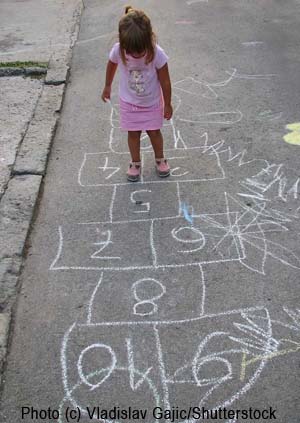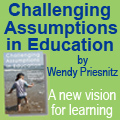The Value of Unstructured Free Play
By Carlo Ricci
 When I was a child, adults played a significant part in our play by allowing us to do it without interference. Unfortunately, this child-structured play is increasingly being replaced by adult-organized, controlled and supervised play. When I was a child, adults played a significant part in our play by allowing us to do it without interference. Unfortunately, this child-structured play is increasingly being replaced by adult-organized, controlled and supervised play.
When I was young, I would simply tell my parents that I was going out here or there and the rest was up to me and my friends. Having to create our own play challenged our creativity and imagination. We had to decide what we wanted to do and we had to make it happen. Sometimes, this took a lot of organizational skills.
For example, if I wanted to play football, I had to make sure that I would round up the necessary number of players to meet at the specified location and ensure that the necessary equipment was available to make it happen.
Playing hockey was an ongoing logistical and organizational process that forced us to be creative and imaginative. We spent months scouring the neighborhood looking for materials that we could use to make the equipment that we needed. We would enthusiastically ride our bikes looking for foam to make goalie pads. We would go to the local arenas and look through the trash bins for sticks that were salvageable. We made our goal nets out of plumbing pipe and meshing that the arena threw out and that we learned to patch.
We organized a hockey league, with teams made up of children who lived on different streets. We named ourselves the Major Street Devils because we lived on Major Street. We made sure that on game day each team would wear the same colored tops. Some teams created their own jerseys. We scouted several locations that were best suited to play hockey, where the ball would remain in play within a confined area and we would not spend the whole game chasing it. We were not bound by adult- controlled, rented space and time limits. We decided for how long we wanted to play. At times, we would just play until we no longer wanted to play; at other times, we played until we reached a certain tally of goals. Once we reached that number, someone would inevitably shout, “five more goals,” or “let’s play again” and we did. Our only limit was the disappearance of the sun. We often played until we could no longer see the ball, and sometimes we played even when we could no longer see the ball. We were largely bound by our own rules.
Most of today’s children don’t make pads and nets. Instead, their parents buy them from for-profit businesses. Then they don’t even organize their own hockey games, but join an organized league where everything is decided for them. It’s as if those of us who created our own unstructured free space as children continue to do it as adults, but this time not for ourselves but for our children. In the process, what are we depriving them of?
I am not suggesting that adults and children should not play together. What I am suggesting is that adults can join the play but they should not control it. I know a woman who is so skilled at playing with children that children swarm her whenever she is around. Every child wants to play with her, because she has retained what most of us have lost: the ability to play. At gatherings, she seems to prefer playing with the children, rather than interacting with the adults. But she doesn’t control the play; she listens, follows, contributes and participates in the play with the children. She becomes a part of the group.
That is not what happens most of the time. And it’s not what happened when my wife and I enrolled our eldest daughter in a gymnastics program. The day that I took her to her class, I was impressed by the quality of equipment that was available for her to play with. I was excited and thought that this was going to be fun for her and for me. However, the fun ended when the adult instructor entered the room. There was nothing wrong with her; in fact, she was a very pleasant and charismatic woman. She was simply doing what she believed she needed to do, which was to teach. Unfortunately, “to teach” has become synonymous with “to control.”
This particular teacher started by asking all of the children to gather around her for a warm-up activity. The activity was inappropriate and teacher-centered. It was inappropriate because it was clear that this was not what the children wanted to do. What ended up happening was that the parents were behind their children like puppeteers and the children were being “marionetted” to follow the teacher’s lead. The parents tried to bribe, cajole and manipulate their children to comply, mostly without success.
I quickly realized that I could not be an accomplice to this and so I politely allowed my daughter to rescue us. We ended up having as great a time as we could in an environment where people thought that our removing ourselves from the group was inappropriate and gave us stares and made comments to indicate that. For example, they would share with their children in a voice that was loud enough for me and my daughter to hear that going off on your own and playing with the equipment is not acceptable and that their children should stay with the group and follow the teacher.
So their children stood in lines waiting to use the equipment, resembling disinterested parts going through an assembly line. Although the children often resisted, the parents quickly rallied them back and forced them to continue along the line. I was left wondering what had happened to the excited bunch of children that I saw playing with the equipment in creative and imaginative ways before the class started. The imposed structure just sucked the life right out of them. Even though there was so much equipment, everyone had to share the same piece, which resulted in them spending most of their time standing around waiting for their turn.
My daughter and I got to play with all of the equipment except for the trampoline. The teacher warned us to stay away from it without her direct supervision. Fortunately, as most children soon find out, beds make great trampolines and so my daughter plays on our bed as if she is on a trampoline. Although she is no longer in gymnastics, she continues to play acrobatically on her own and with her friends. She can somersault, do cartwheels and plays with the equipment at the local park.
It’s the same in her swimming class. In this class she is forced into the same situation where the children are expected to obey orders and not initiate the play. The swim instructor is pleasant and comfortable around children. And the children are comfortable around her. However, she still falls prey to the teaching myth. Again, my daughter spends much of her time waiting to follow an instruction, at which point she half-heartedly does it, not because she wants to but because she wants to please her instructor, whom she adores. After her first set of lessons in an indoor pool, her progress, according to the instructor, was “acceptable,” even though she hadn’t previously spent much time in the water. As summer came around, we were invited to our friends’ homes to swim in their backyard pools. During this unstructured play time, her skill development just took off. We put water wings on her and allowed her loose. She played with other children her age, and they challenged and dared each other to do more “risky” things until they were doing things that awed us.
When we finally signed her up again for lessons, we were amazed at how different she was in a structured class environment versus playing on her own. She enjoyed being around the instructor, but her comfort level and skill development had nothing to do with the lessons and everything to do with her self-initiated unstructured play. Clearly, learning how to swim requires this sort of play, rather than obedience to others’ directions.
I would like to share one more example. This same daughter recently turned three and we had a party for her at a local grocery store where the children made their own pizzas and decorated their own cakes. During this activity, some of the parents took over the pizza making and cake decorating to create beautiful looking cakes…except that the point of the party was to have the children enjoy cooking, rather than to watch their parents. Even more curious was that the other parents were looking at me as if I was a negligent parent for not showing my daughter how to do it “right” and for not doing it for her so that it looked “proper.”
When we first entered the party area, there were balloons scattered on the floor. As the adults huddled along the walls, the children enthusiastically engaged in creative and imaginative play with the balloons. But it was the facilitator’s job to run activities. As soon as this pleasant and personable woman began to interfere, the children’s play was stifled. She tried to control what they did, tried to lead structured activities and set limits to where children could roam, attempts that were ignored by the children. Thinking I would rescue both her and the children, I politely offered for her to let them be. Once she did, the noise level went up and the children were once again enthusiastically initiating play – something they do naturally, without our help. Children know how to play and will learn from that play…if only adults who have forgotten how can stop interfering with their enjoyment, creativity and imagination.
Carlo Ricci teaches in the faculty of education’s graduate program at Nipissing University and edits the journal JUAL. He incorporates the spirit of unschooling, democratic and learner-centered principles in his classes. Everything of value that he has learned, he has learned outside of formal schooling; he has never taken a course in school connected to what he now teaches and writes about. This article was first published in Life Learning Magazine, which is one of Child's Play Magazine's sister publications.
Copyright © Life Media
Privacy Policy
 



|

